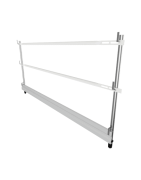Edge Protection Clamp for vertical or horizontal installation
Clamp that allows for horizontal or vertical fixation intended for temporary edge protection....
Temporary edge protection systems according to EN 13374 provide an effective measure to prevent the risk of falling. We offer 3 very different protection systems with guardrails.
Temporary safety guardrails for edge protection
Guardrails are a temporary safety system. This system complies with the UNE EN 13374 standard. They are important to prevent falls when working at heights. They provide an effective solution for securing workers in high places or on construction sites. We offer 3 groups of guardrails for very different construction sites:

Active filters
Clamp that allows for horizontal or vertical fixation intended for temporary edge protection....
Post for guardarail railing installation. EN 13374.
Height: 1300 mm
Post for vertical safety net installation.
Height: 1800 mm
Fixed support for mounting on facade or vertical surfaces.
Projection: 150 mm
Fixed support for mounting on facade or vertical surfaces.
Projection: 500 mm
Fixed support for mounting on facade or vertical surfaces.
Projection:...
Fixed support for installation on narrow-edge beams.
Projection: 300...
Fixed support for installation on beams with reduced depth.
...Post with adjustable base for vertical, horizontal, or inclined installation.
Handrail...
Adjustable support for mounting on facade or vertical surfaces.
...EN 13374 is a European standard that establishes the technical requirements and test methods for temporary edge protection systems. These systems include guardrails and other components designed to prevent falls from height, ensuring worker safety in construction and other high-risk environments.
One of the main advantages of edge protection systems that comply with EN 13374 is their ease of installation and dismantling. This feature is crucial on construction sites where mobility and flexibility are essential. The standard also includes specifications for fastening devices and safety nets, which enhance protection and minimize the risk of falling objects.
Depending on the slope of the working surface, edge protection systems are classified into three categories:
This classification ensure that guardrails meet strength, stability, and durability requirements to prevent accidents in temporary work at height.
A compliant temporary edge protection system consists of several components designed to ensure effective fall prevention:
When selecting a temporary edge protection system, it is crucial to ensure that all components work together to provide full protection:
If a permanent solution is required, it is essential to refer to EN 13774, which provides guidelines for fixed guardrails and permanent edge protection solutions.
The height of the vertical post in an EN 13374-compliant edge protection system depends on the class of the system and the required safety features. However, the standard specifies:
Minimum height of the top railing (handrail): 1.10 metres (110 cm) from the working surface, with a tolerance of ±20 mm.
Post height must be sufficient to support the top rail, intermediate guardrail, and skirting board while maintaining stability and load resistance.
General Post Heights Based on System Type:
For Class A systems (up to 10° inclination): Typically around 1.20 to 1.30 metres, considering additional height for fixings.
For Class B and C systems (steeper inclinations up to 30° or 60°): Posts may be higher to accommodate the additional guardrails, safety nets or extended protection.
The exact height of the vertical post will also depend on factors like fixing method, guardrail design, and additional safety components. Would you like recommendations for a specific application? please contact us
If you need a quote for edge protection systems, contact us at +34 965 248650. Our sales team will provide a customized proposal based on the following details: